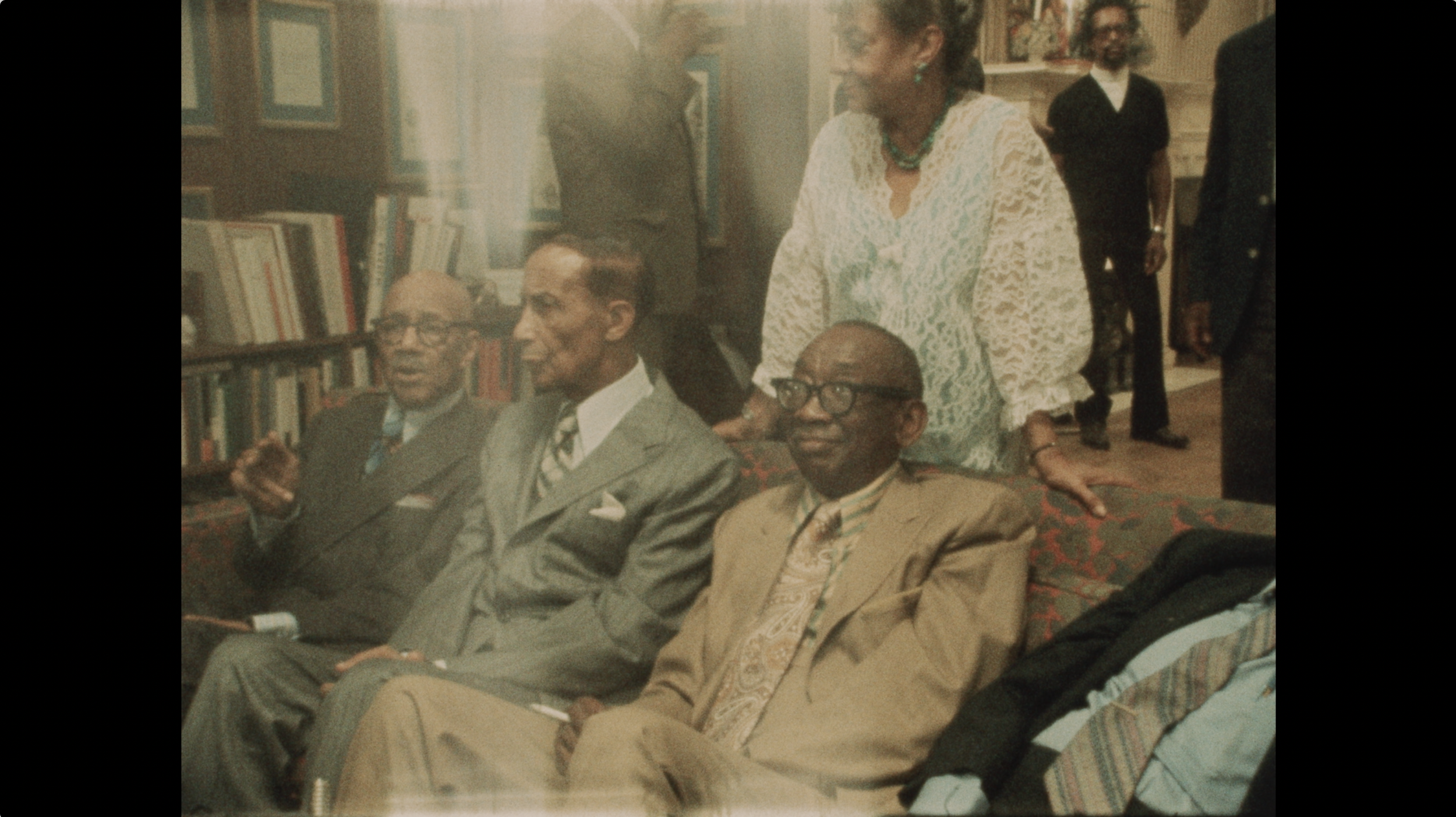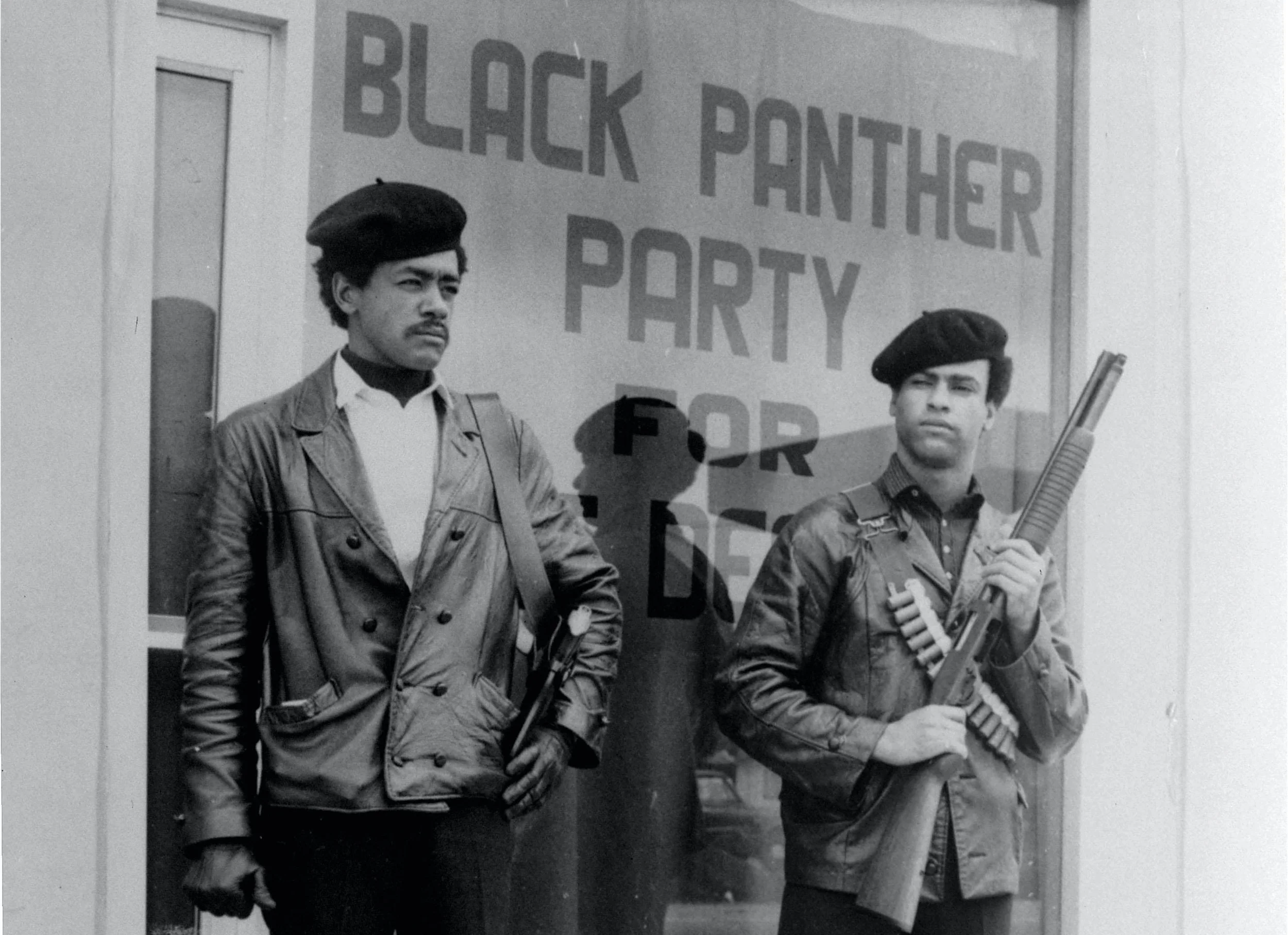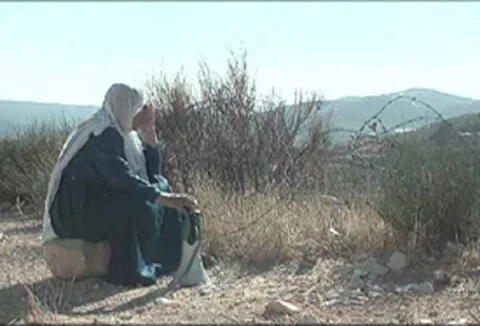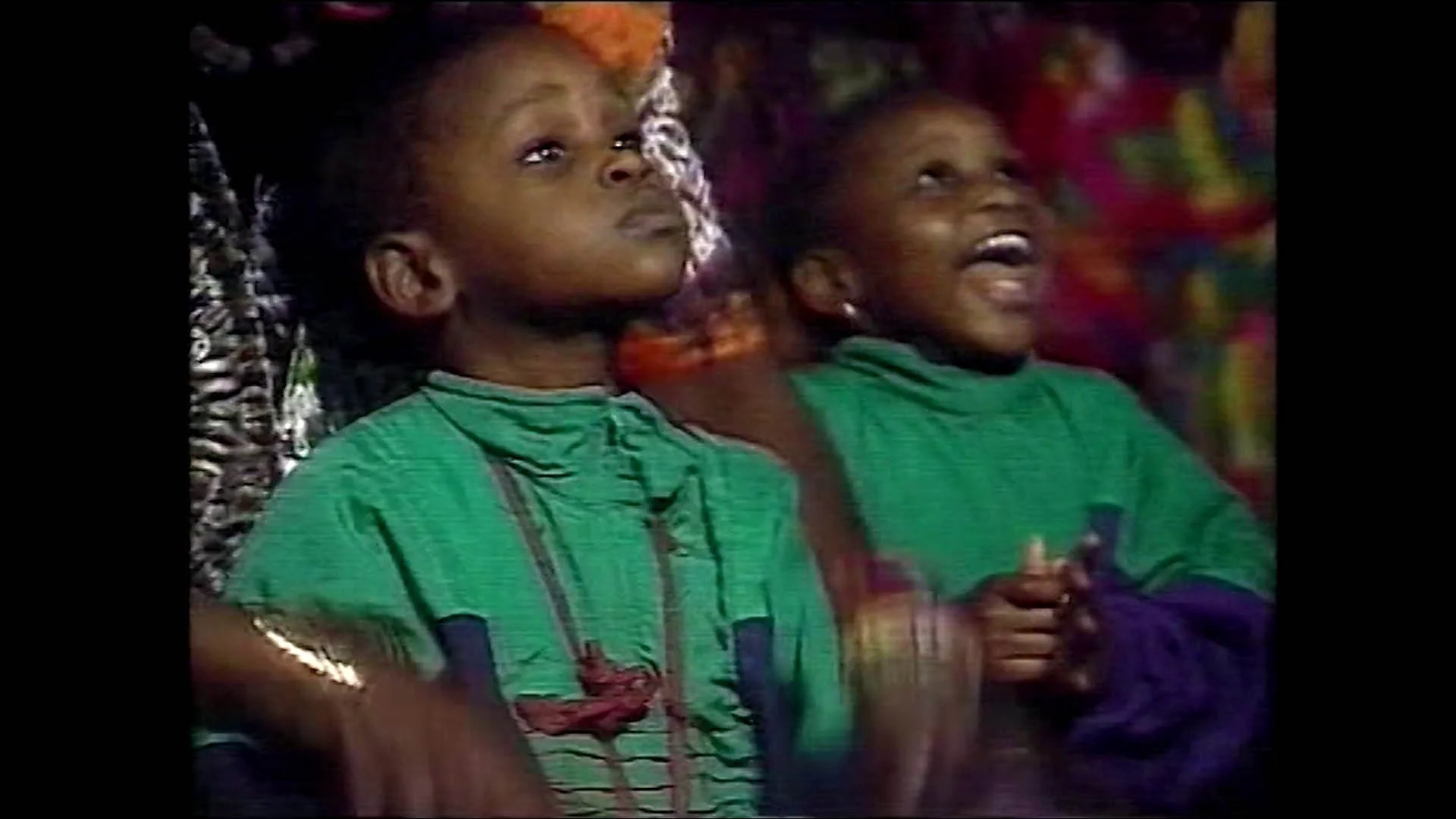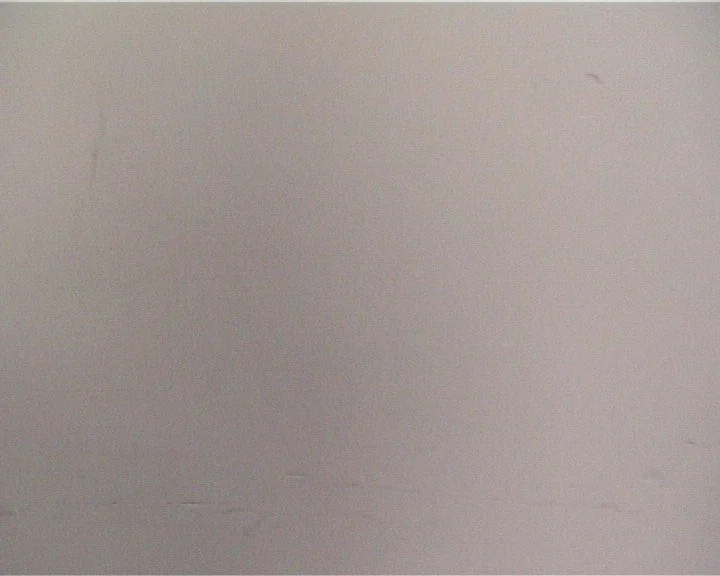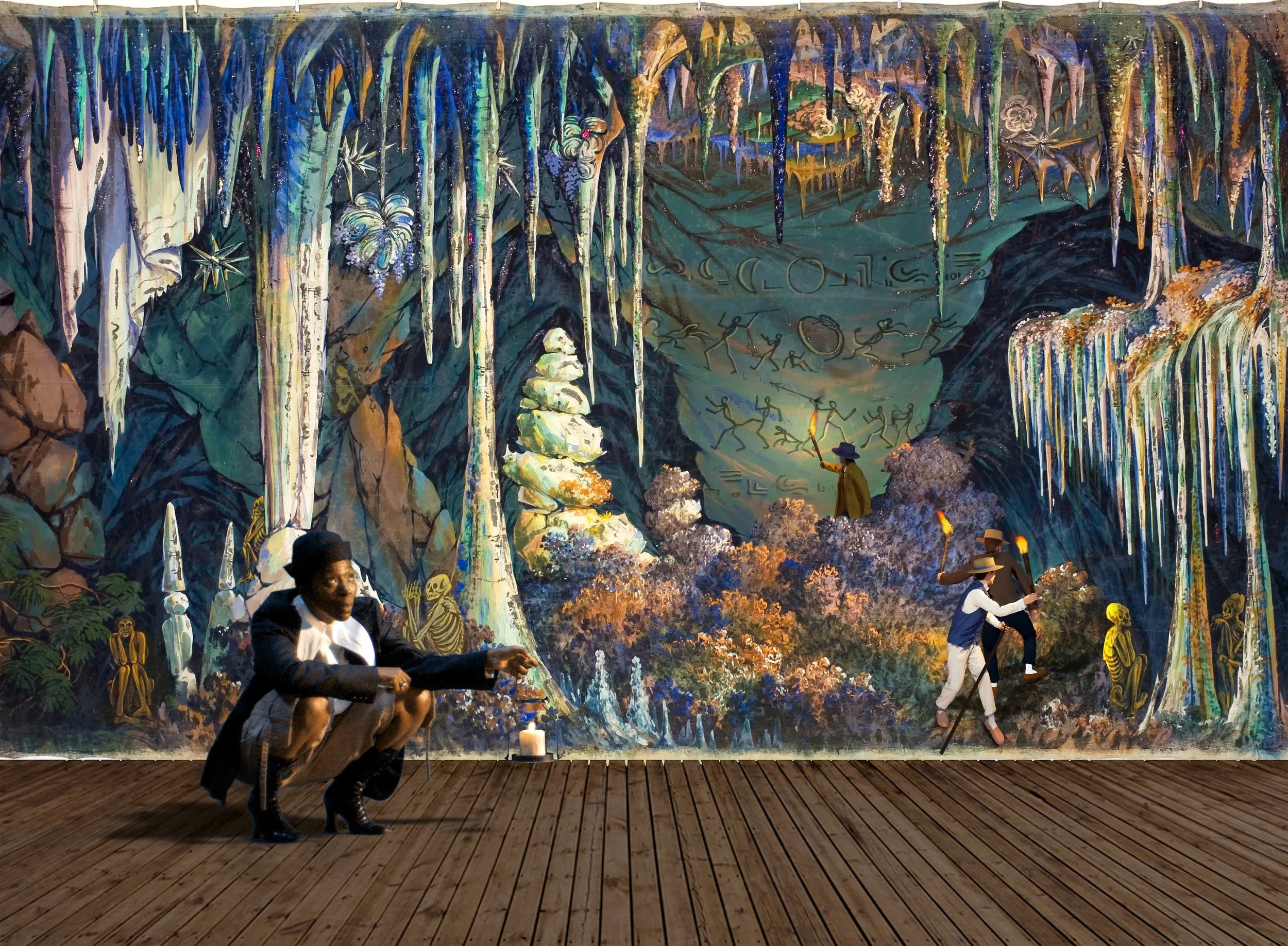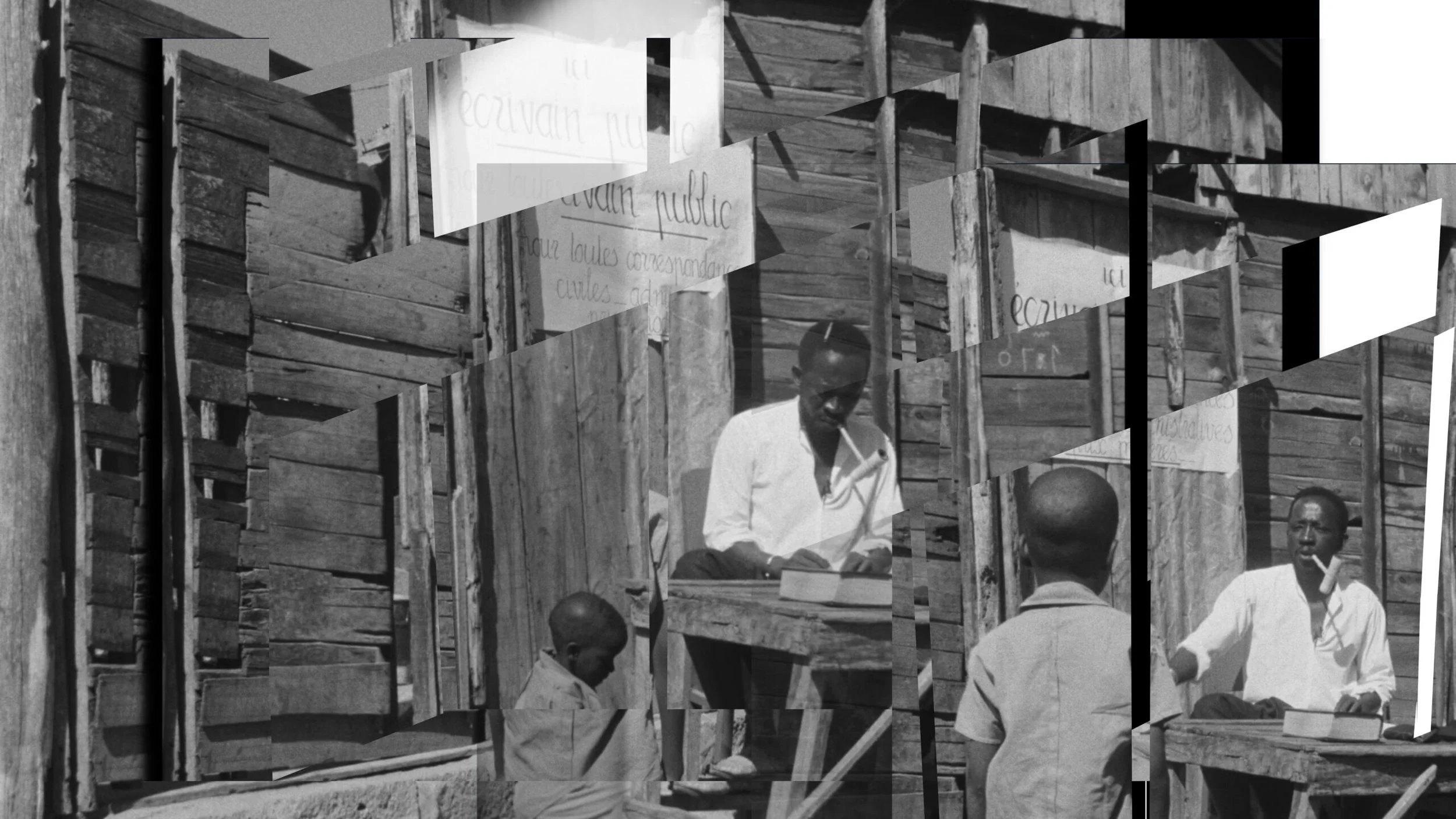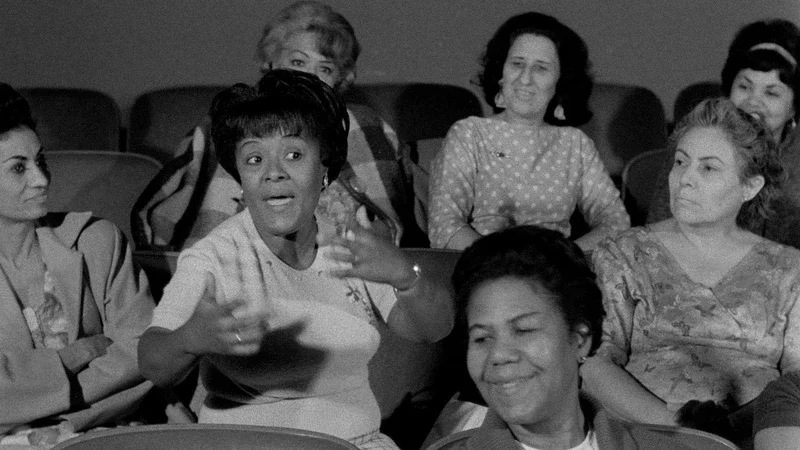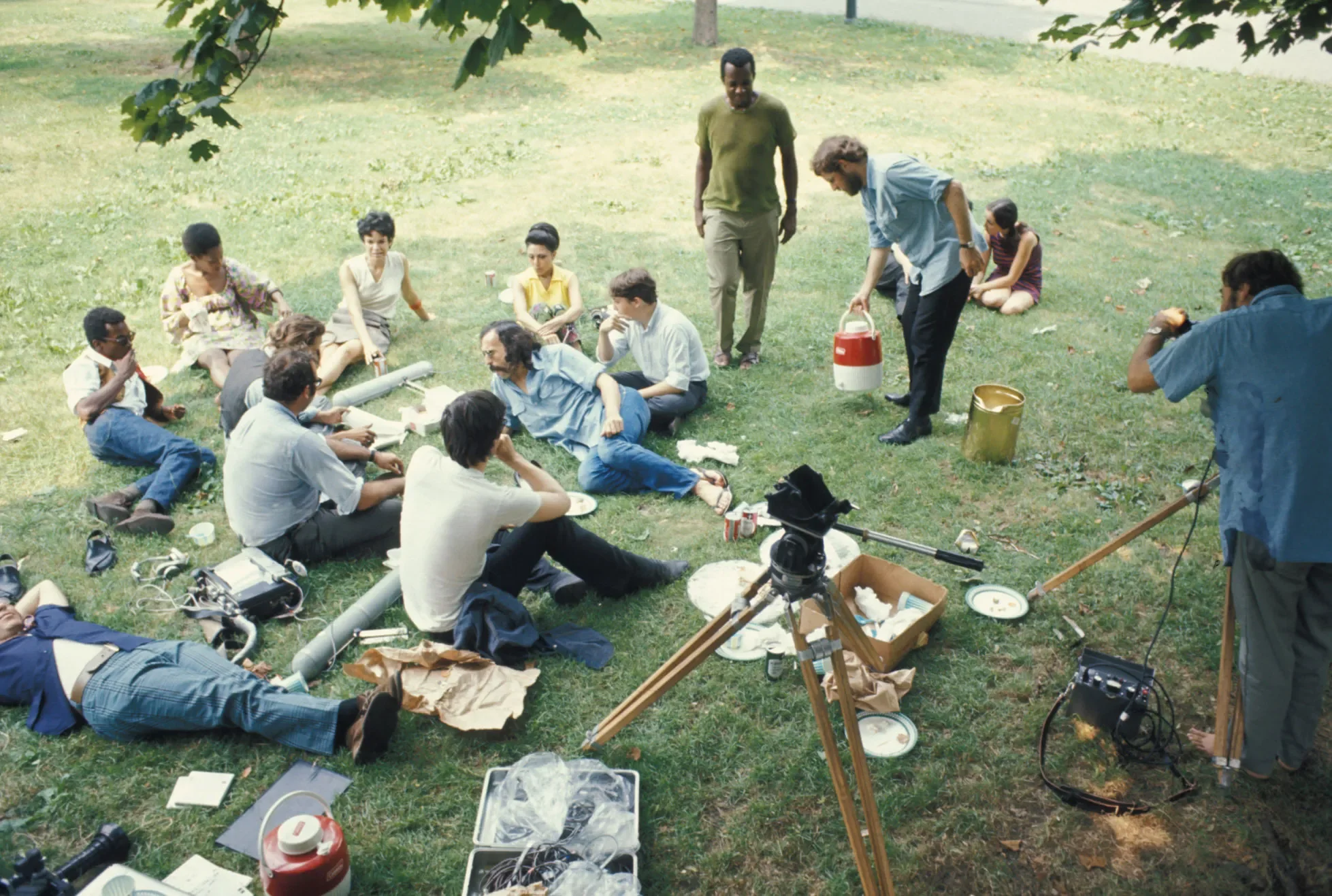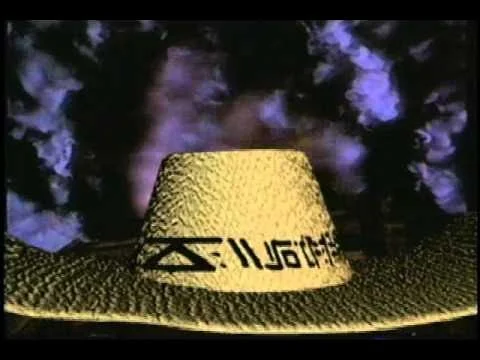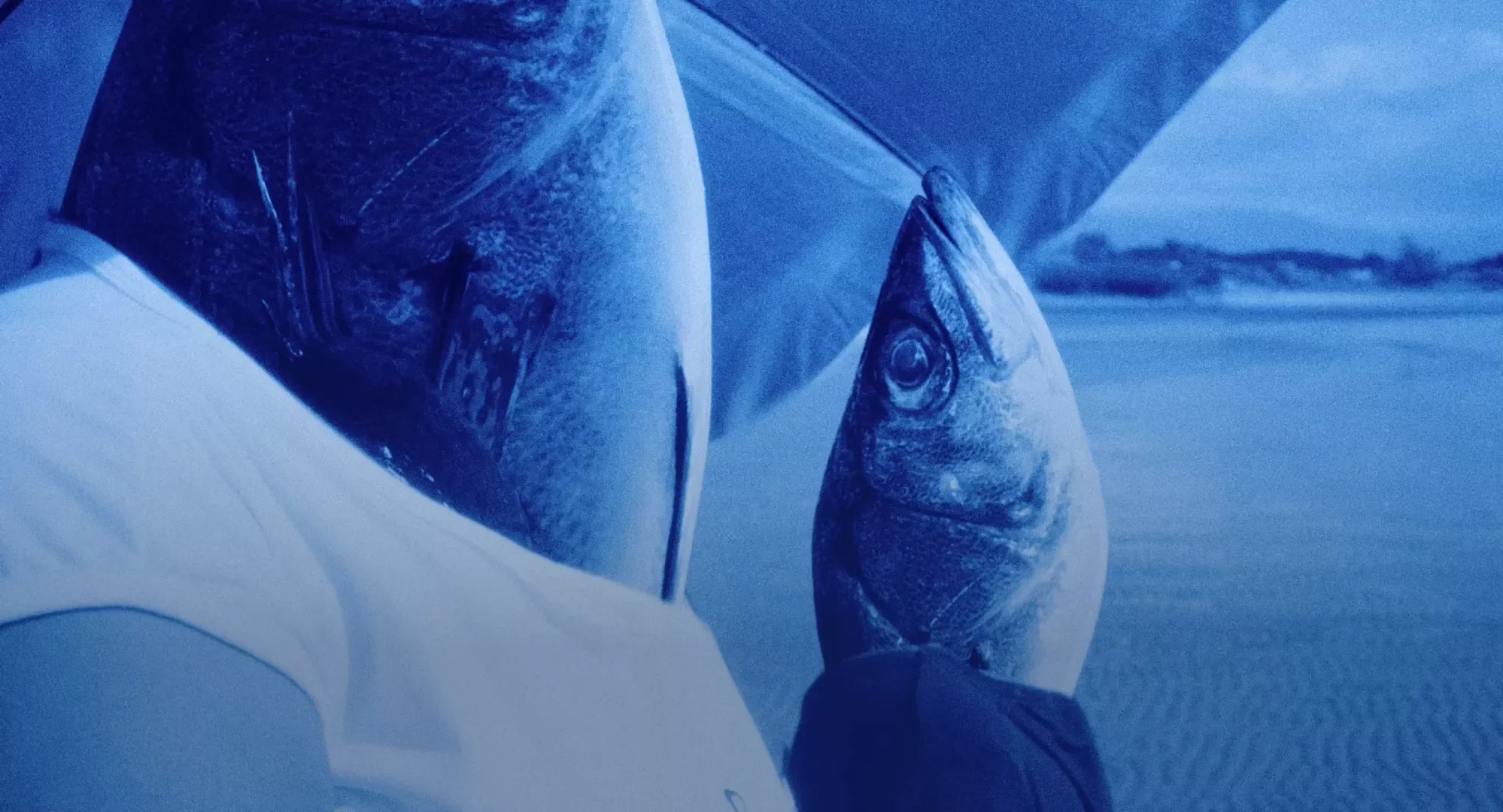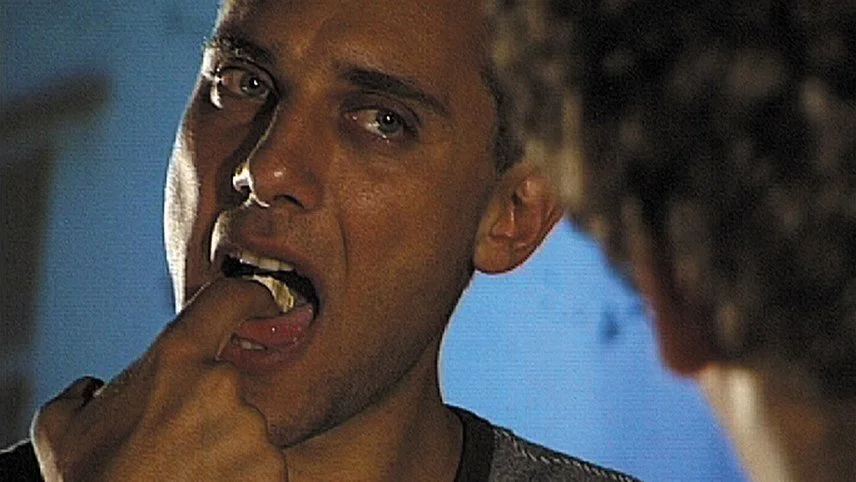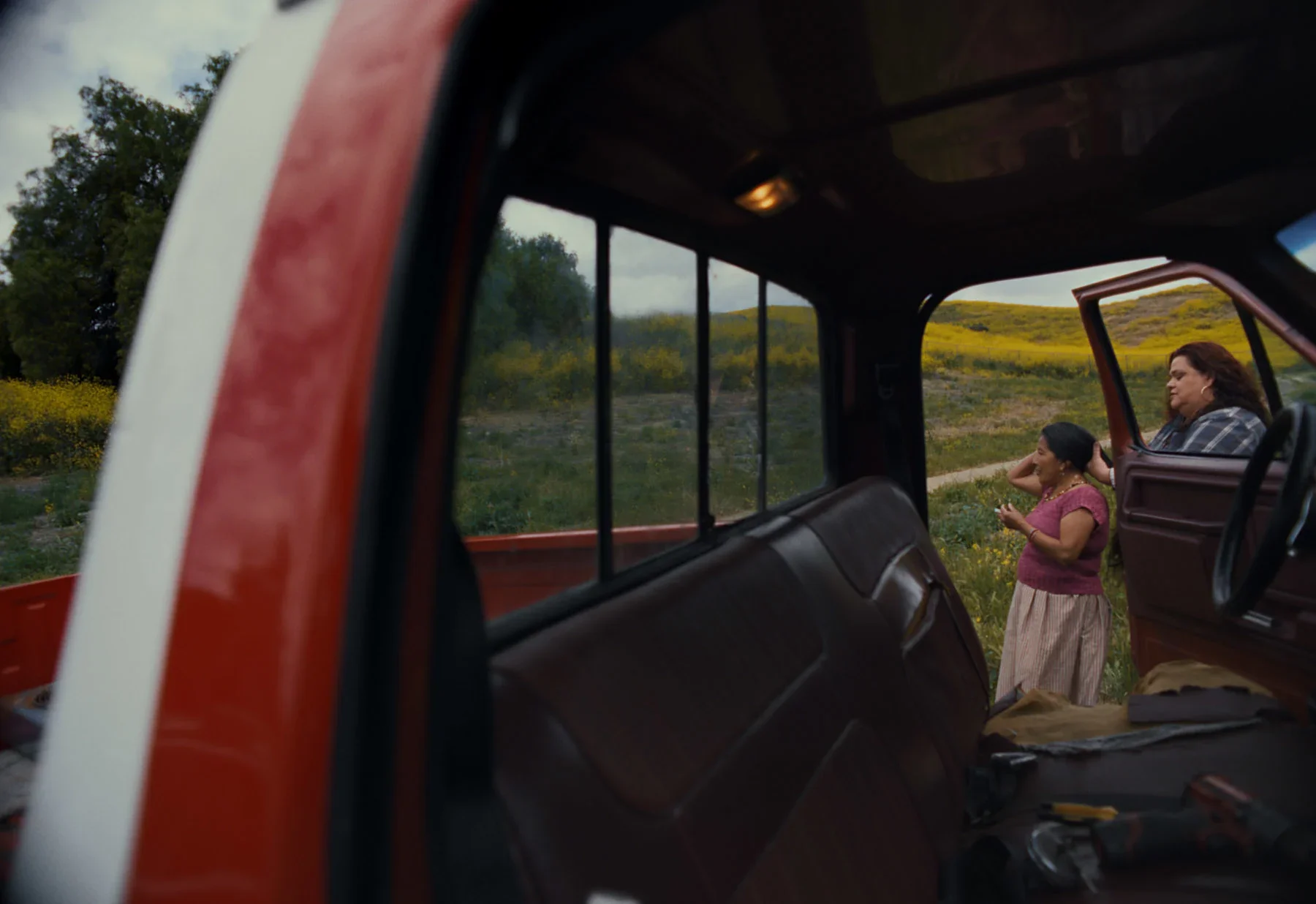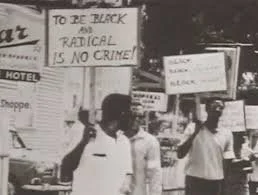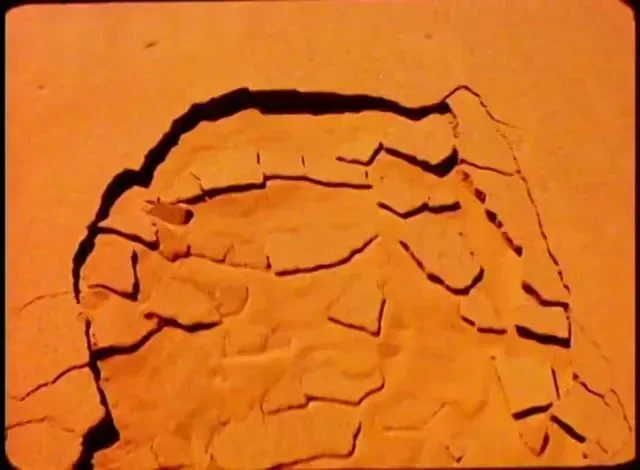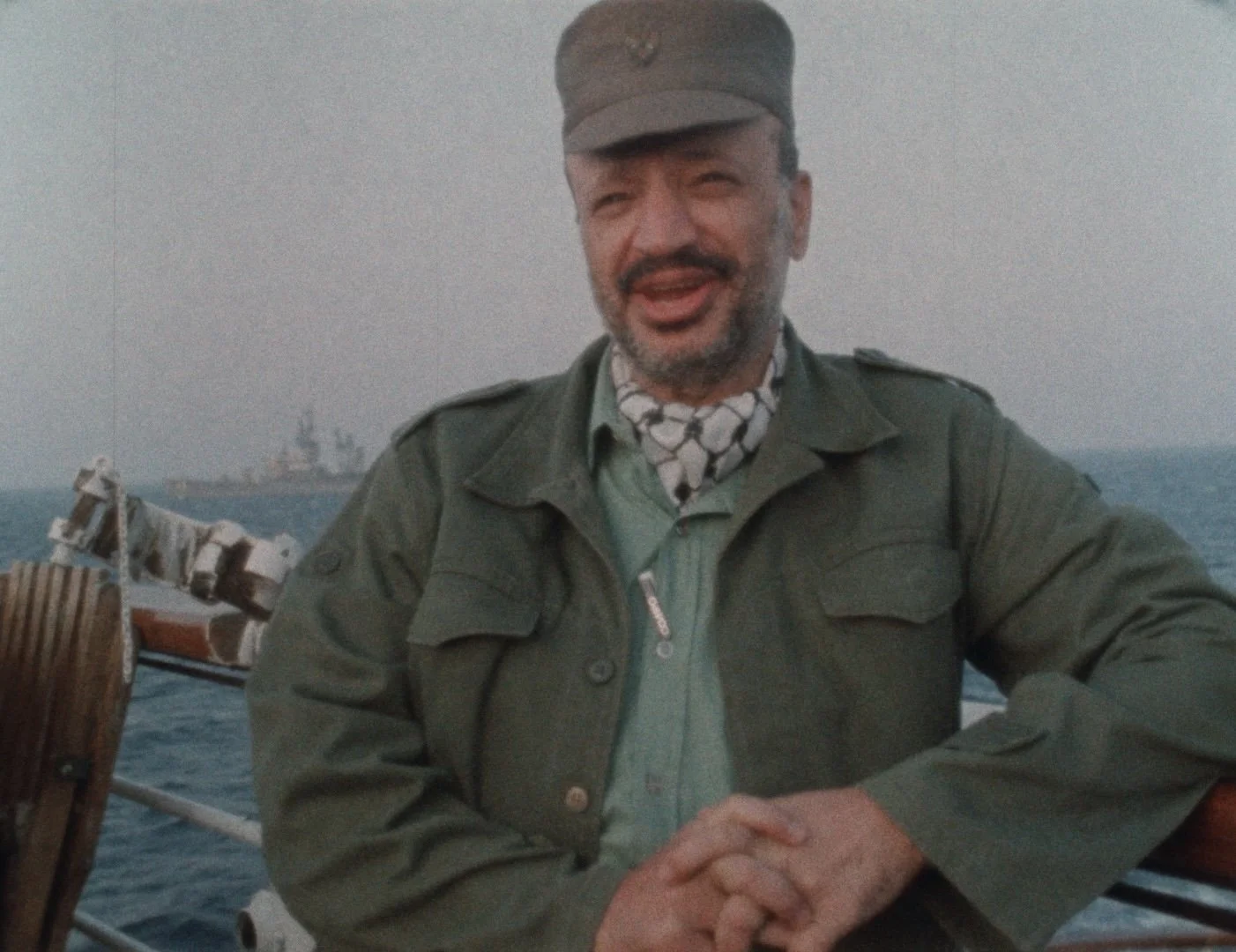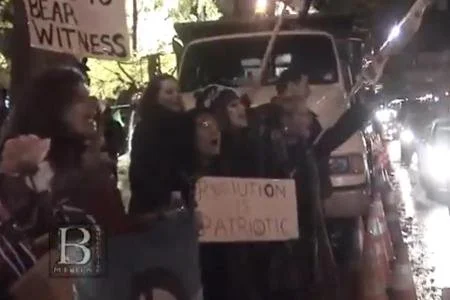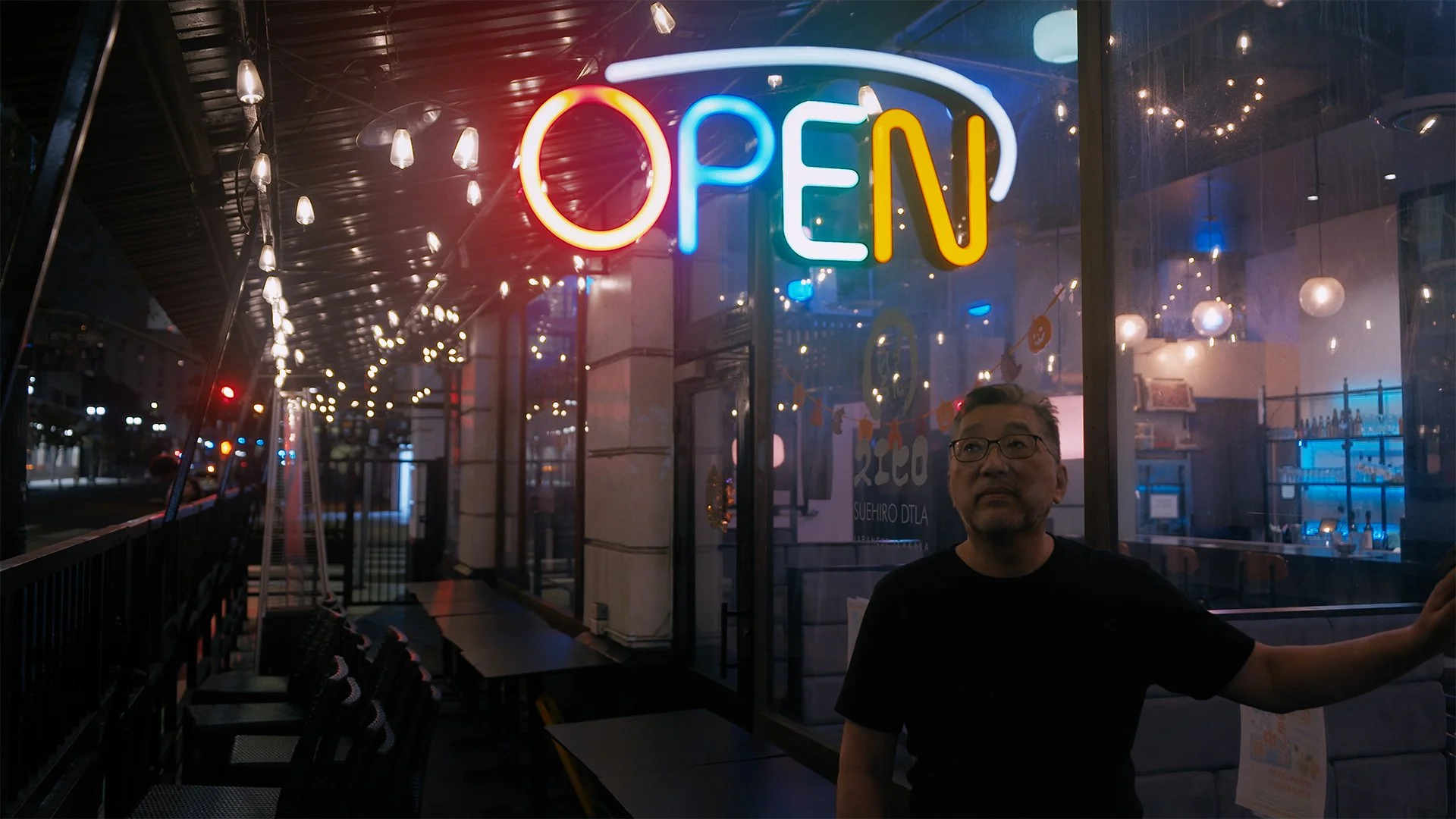Program 1
Thursday, June 26
HARLEM REALIZATION: A LIVE CINEMA FILM BY JON-SESRIE GOFF
Harlem Realization is a live cinema performance composed of four movements, blending portraiture, oral history, archival research, sound, and experimental form into a layered meditation on memory, displacement, and Black cultural inheritance. The piece opens with the first 1 minute and 45 seconds of William Greaves’ The First World Festival of Negro Arts, grounding the work in a diasporic frame that links Harlem to Dakar, Senegal and to the enduring cultural current between Africa and Harlem.
Through its live visual and audio storytelling, the piece surfaces the constant wave of migration, forced and chosen, that brought generations of Africans to the shores of Manhattan, shaping Harlem across the centuries. Interviews with artists, elders, spiritual leaders, and cultural workers animate the neighborhood’s past and present, offering a sonic and visual chorus of what remains, what transforms, and what resists erasure.
Movement I foregrounds contemporary testimonies from Harlem residents. It includes a reading of the poem “Dawn in New York” by Claude McKay recorded by Noel W Anderson. Movement II features a live DJ mix by DJ
George Twopointoh over rare outtakes from Greaves’ The First World Festival of Negro Arts. Movement III is anchored by Greaves’ prophetic 1970 New York Times op-ed “100 Madison Avenues Will Not Save You.” Movement IV returns to present-day Harlem, threading personal memory with collective vision.
Harlem Realization presents Harlem as a living archive, a site of beauty, struggle, migration, transformation, and imagination, and honors those who have preserved and reimagined its meaning across generations and geographies. —
*Jon-Sesrie Goff | Director, Producer, Editor, Audio Recorder
Jenna Bond | Writer And Co-Producer
Daniel Patterson | Cinematographer
Javonn Patterson | Assistant Camera
Featuring Noel W. Anderson, Rev. Dr. Travis Boyd, Dr. Lena L. Green, Dsw, Lcsw, Russell Poole, Dianne Smith, Lillian Taylor, Susan Taylor, Tay Tiwoni, Lana Turner, Kara Young, Klay Young
William Greaves | Archival Narration
Dj George Twopointoh | Movement Ii Dj Performance Poetry By George Twopointoh & Jon-Sesrie Goff Percussion by Compton A. Timberwolf
Archival Visuals Outtakes From The First World Festival Of Negro Arts Directed By William Greaves
Movement III Anchored By “100 Madison Avenues Will Not Save You” A 1970 Op-Ed By William Greaves
ONCE UPON A TIME IN HARLEM (WORK IN-PROGRESS) | WILLIAM GREAVES, DAVID MARK GREAVES, USA, 39’ (EXCERPT)
In the summer of 1972 filmmaker William Greaves invited every surviving member of the Harlem Renaissance he could find – writers, artists, musicians, activists – to a cocktail party at Duke Ellington’s home in Harlem and brought three camera crews to film what unfolded. He originally intended the footage to be part of From These Roots, a history of the Harlem Renaissance he was working on at the time, but Greaves soon came to believe the party to be the most important event he ever captured, and that it needed to be a film in its own right. He would return to Once Upon a Time in Harlem a number of times over the course of his long and prolific career, yet the work remained unfinished at the time of his passing.
In 2007, Greaves wrote, “Once Upon a Time in Harlem is not a historical documentary. It will look at African American culture from the perspective of the artists, writers, and activists who took up the challenge of defining themselves as members of a distinct community in a society that did not recognize them as equals. My hope is that it will help us understand the creative process, how it has served the African American people, and what they have contributed to American and world culture.”
Once Upon a Time in Harlem spans both cultural and familial generations. William Greaves aspired his whole life to “live up to the expectations of the Harlem Renaissance.” Born in Harlem in 1926 at the height of Renaissance, Greaves grew up in the shadow of many of the artistic and intellectual giants captured here on film. William’s son David worked alongside his father – behind the
camera and in the edit room – for over 15 years before shifting the focus of his own life’s work to journalism. Significantly, he was one of the three cameramen in the room in 1972 filming with his father. William Greaves’ passing led his widow and life-long filmmaking partner Louise to take up the project again. Until her last breath, Louise worked on this film, and during that time Greaves’ son David and granddaughter Liani committed to continuing this important work.
Shown tonight were the first 39 minutes of the current work-in-progress feature, a project over 50 years in the making. The filmmaking team is actively raising funds to complete Once Upon a Time in Harlem in time for a 2026 release, on the centennial of William Greaves’ birth.
Contact William Greaves Productions: http://www.williamgreaves.com/contact-page/
Program 2
Friday, June 27
THE BUS (1965) | HASKELL WEXLER, USA, 61’
The Bus, a documentary film by lifelong activist and Academy Award-winning cinematographer Haskell Wexler, gives agency to the anonymous faces at the 1963 March on Washington for
Jobs and Freedom, capturing in intimate detail the story of one small group of individuals that traveled across the country to stand in the shadow of the Washington Monument and demand equality and human rights for African Americans. Self-funded, produced and photographed by Wexler with a skeleton crew that included filmmakers Nell Cox and Mike Butler, the hour-long vérité documentary begins in San Francisco as an integrated group of 37 people, young and old, embark on a three-day cross-country road trip organized by the Congress of Racial Equality (CORE).
The Bus screened at the 1964 Flaherty Film Seminar programmed by Jane Beveridge, alongside James Blue’s The March, and works by Joyce Chopra, Shirley Clarke, Yasujirō Ozu, Satyajit Ray, Amilcar Tirado, Madeline Tourtelot, George Stoney (& others).
The Bus was restored by the UCLA Film & Television Archive with funding provided by the National Film Preservation Foundation.
Distribution: UCLA Film Archive, movies@cinema.uca-edu
POWER! (1966-68), EYES ON THE PRIZE: PART II (1990) | LOUIS MASSIAH, TERRY ROCKEFELLER, USA, 56’
Eyes on the Prize recounts the fight to end decades of discrimination and segregation. It is the story of the people — young and old, male and female, northern and southern — who, compelled by a meeting of conscience and circumstance, worked to eradicate a world where whites and Blacks could not go to the same school, ride the same bus, vote in the same election, or participate equally in society. It was a world in which peaceful demonstrators were met with resistance and brutality — in short, a reality that is now nearly incomprehensible to many young Americans.
The call for Black Power takes various forms across communities in black America. In Cleveland, Carl Stokes wins election as the first Black mayor of a major American city. The Black Panther Party, armed with law books, breakfast programs, and guns, is born in Oakland. Substandard teaching practices prompt parents to gain educational control of a Brooklyn school district but then lead them to a showdown with New York City’s teachers’ union.
Distribution: PBS Theatrical Distribution theatrical@pbs.org
THE SUMMER OF OUR DISCONTENT (EXCERPT) | SPEECH GIVEN BY MARTIN LUTHER KING, JR. AT THE NEW SCHOOL FOR SOCIAL RESEARCH ON FEBRUARY 6, 1964
Standing before a packed house at the Auditorium at 66 West 12th Street (this very venue) on February 6, 1964, Rev. Dr. Martin Luther King, Jr. spoke against the injustices plaguing American society: economic hardship in black communities, resistance to civil rights legislation among the political elite, and inequality in the country’s public school system:
“In short, if this problem is to be solved, there must be a sort of divine discontent and a determination on the part of people of good will to work passionately and unrelentingly to see that the dignity and worth of the human personality will be respected. I have often mentioned the fact that if this problem is to be solved, somebody will have to get upset enough to work with determination to see that it is solved.”
However, King, always the uplifting orator, concluded with a hopeful message. Calling on the world to reject the status quo thinking holding back the Civil Rights Movement:
“...we will be able to emerge from the bleak and desolate midnight of man’s inhumanity to man, into the bright and glittering daybreak of freedom and justice.
With this kind of work and with this faith, 1964 can be a great year of achievement. With this faith, we will be able to adjourn
the councils of despair and bring new light into the dark chambers of pessimism. With this faith, we will be able to transform the jangling discords of our nation into a beautiful symphony of brotherhood.”
King was prescient in his optimism: just months later, Congress would pass the Civil Rights Act, groundbreaking legislation for which the civil rights leader had fought so hard.
Program 3
Saturday, June 28
A PLATE OF SARDINES (1997) | OMAR AMIRALAY, SYRIA, 18’
In the company of fellow Syrian filmmaker Mohammad Malas, the ground-breaking director Omar Amiralay revisits the ruins of the destroyed Golan village of Quneytra, occupied by Israel and then abandoned following the 1973 war. A Plate of Sardines was programmed by Irina Leimbacher for the 2009 Seminar, “Witness, Monuments and Ruins”.
Distribution: Arsenal - Institut für Film und Videokunst e.V., distribution@arsenal berlin.de
MOUNE Ô (2022) | MAXIME JEAN-BAPTISTE, BELGIUM, FRENCH GUIANA, FRANCE , 16’
I close my eyes. The crowd makes me smile, breaks my body, and that’s the end. By presenting the festive events which escorted the projection of the film Jean Galmot aventurier by Alain Maline, where the filmmaker’s father played a role, the images of Moune Ô reveal the survival of the colonial inheritance within a Western collective unconscious always marked of stereotypes. From little gestures of daily life, the resistance toward oppression comes in its own rhythm.
Distribution: Square Eyes, info@squareeyesfilm.com
WHITE WALL TEHRAN (2007) | ANAHITA RAZMI, IRAN, 2’
“In January 2007 I was stopped by the Iranian revolution guard on the streets in Tehran, because I had apparently been filming them with my video camera. They took me in and erased 27 seconds of my video by filming the white inner wall of their headquarters. The erasure is now producing the art work.”
Distribution: Anahita Razmi, mail@anahitarazmi.de
CIEN NIÑOS ESPERANDO UN TREN / ONE HUNDRED CHILDREN WAITING FOR A TRAIN (1988) | IGNACIO AGÜERO, CHILE, 56’
One Hundred Children Waiting for a Train poetically tells the story of a group of Chilean children who discover a larger reality—and a different world—through the cinema. Each Saturday, Alicia Vega transforms the chapel of Lo Hermida into a film screening room as she conducts a workshop for children under the auspices of the Catholic church. The hundred or so children involved had never seen a movie, and in the workshop they see and learn about the cinema: photograms and moving images, projection, camera angles and movement, film genres, and much more. And they watch movies: Chaplin, Disney, Lamorisse’s The Red Balloon, the Lumieres’ The Arrival of the Train to the Station. Finally, each child designs his own film with drawings. And then, for the first time in most of their lives, the children got to the movies in downtown Santiago. One Hundred Children Waiting for a Train played at the 1989 Flaherty Film Seminar programmed by Pearl Bowser and Grant Munro.
Distribution: Icarus Films, rentals@icarusfilms.com
Program 4
Saturday, June 28
AL MAHATTA / THE STATION (1989) | SUDANESE FILM GROUP, SUDAN, 15’
Set in Sudan in the late 1980s, people cross the desert on foot or cover long distances by car and truck. In Al Mahatta, Eltayeb Mahdi shows encounters at one of the large crossroads between the capital Khartoum in the centre of the country and Bur Sudan on the Red Sea.
Distribution: Arsenal - Institut für Film und Videokunst e.V., distribution@ arsenal-berlin.de
THE DEEP WEST ASSEMBLY (2025) | CAULEEN SMITH, USA, 35’
The Deep West Assembly delves into the concepts of geological time and Blackness as camouflaged in image, song, and word by Black and Brown creators (after thinkers such as Suzanne Césaire and Ryan C. Clarke). Incorporating images of geological formations like lava caves, calderas, and salt domes, as well as human-made landforms such as ancient Choctaw burial mounds, The Deep West Assembly paints a view of the American South as a horizontal “Deep West” (a term borrowed from poet Wanda Coleman). Smith situates this cultural Deep West in the Mississippi River Delta, exploring Black cultural practices as kin to Indigenous traditions. Actor Dionne Audain embodies multiple voices—guides—reading, among other texts, Smith’s recent Volcano Manifesto (F Books, 2022) for the camera. —ASTRUP FEARNLEY MUSEET
America’s violent history of settler colonial extraction and enslavement is posited against the expansive lens of geologic time in The Deep West Assembly. Co-mingling theater and computer animation, textiles and dance, and Black and Indigenous cultural traditions, Cauleen Smith locates an anti-racist methodology for the end of the world in the spaces underground, where the interior of the Earth becomes a place of possibility and new ways of relating.
Distribution: Cauleen Smith Studio, cauleensmithstudio@gmail.com
VERS LES COLONIES / TOWARD THE COLONIES (2016) | MYRIAM CHARLES, CANADA/HAITI, 5’
When a young girl is found off the Venezuelan coast, a medical examiner will try to determine the cause of death.
Distribution: La Distributrice de Films, ladistributrice.ca / serge@ladistributrice.ca
MASCON (2025) | OTOLITH GROUP, UK, 32’
Think of Mascon: A Massive Concentration Of Black Experiential Energy as an audiovisual investigation into the gestures, geometries, grammars and geographies that compose the forms and the forces of the films of Ousmane Sembene and Djibril Diop Mambety from 1963 to 2004.
As an audiovisual mosaic of still moving images and sounds adapted from the frames of the narratives of Mambety and Sembene in order to circulate in a migratory orbit that summons the borderless imagination of the cine-Sahel. As morphologies that amplify the Sembenean and Mambetyan motifs of Cinemafricana until they assail the imagination with the expansive deformation, centrifugal
contraction, compacted compression, and amassed concentration that Stephen Henderson calls ‘Mascon’ or ‘black experiential energy’.
Distribution: LUX, distribution@lux.org.uk
JUST BECAUSE YOU CAN’T SEE IT (2018) | KARRABING COLLECTIVE, AUSTRALIA, 3’
Produced for Dazibao, Montréal. A serious, sometimes humorous, reflection on Karrabing understandings of the ancestral present.
Distribution: Karrabing Collective, karrabing.info
Program 5
Sunday, June 29
MY CALDERA (2022) | CAULEEN SMITH, USA, 5’
“In My Caldera, imagery of the film is of volcanic scenes in various life stages, from pouring magma to inert mountain, with colors unnaturally saturated—purple, blue, and orange. The scratchy, chaotic aesthetic is created through Smith’s proprietary process of placing TikTok video stills onto 35 mm film, then rendering it in 4K as an artifact of the original footage. A driving, heavy metal soundtrack provides an apt audio accompaniment to the visual onslaught of nature’s rage. A common thread in Smith’s work, this exhibition looks to nature for an alternative—to draw an analogy to human dynamics.”–MORÁN MORÁN
Distribution: Cauleen Smith Studio, cauleensmithstudio@gmail.com
TAKE YOUR BAGS (1988) | CAMILLE BILLOPS, USA, 11’
“My take on slavery: when the Africans boarded the ships bound for America, they carried in their bags all their memories of home. When they arrived in the New World, their bags had been switched... Many generations later, the children of these Africans toured the Museum of Modern Art to see the sculptures and art of Picasso, Braque
and Matisse. Lo! There were the beautiful icons of their ancestors, the images that had been stolen from their bags.”
—CAMILLE BILLOPS
Distribution: Third World Newsreel, twn@twn.org
MI APORTE / MY CONTRIBUTION (1969) | SARA GOMEZ, CUBA , 33’
An illustration of the difficulties women encounter when they seek to achieve economic integration and equality with men in a country at the height of revolution.
Digitized, subtitled, and restored by the Vulnerable Media Lab at Queen’s University situated on the territory of the Haudenosaunee and Anishinaabek as part of the Sara Gomez Project. This is the result of four years of work undertaken in the Vulnerable Media Lab by six graduate students, two post doctoral fellows and three undergraduates. Afro-Cuban filmmaker Sara Gómez made 19 documentaries and a feature film in Cuba before her untimely death at 34 in 1974.
Distribution:
Criterion/Janus: booking@janusfilms.com
Susan Lord at the Vulnerable Media Lab: lords@queensu.ca
Instituto Cubano del Arte e Industria Cinematográficos (ICAIC), cubacine. icaic.cu/es
ONCE UPON A TIME IN HARLEM (WORK IN-PROGRESS) | WILLIAM GREAVES, DAVID MARK GREAVES, USA, 25’ (EXCERPT 2)
In the summer of 1972 filmmaker William Greaves invited every surviving member of the Harlem Renaissance he could find – writers, artists, musicians, activists – to a cocktail party at Duke Ellington’s home in Harlem and brought three camera crews to film what unfolded. He originally intended the footage to be part of From These Roots, a history of the Harlem Renaissance he was working on at the time, but Greaves soon came to believe the party to be the most important event he ever captured, and that it needed to be a film in its own right. He would return to Once Upon a Time in Harlem a number of times over the course of his long and prolific career, yet the work remained unfinished at the time of his passing.
In 2007, Greaves wrote, “Once Upon a Time in Harlem is not a historical documentary. It will look at African American culture from the perspective of the artists, writers, and activists who took up the challenge of defining themselves as members of a distinct community in a society that did not recognize them as equals. My hope is that it will help us understand the creative process, how it has served the African American people, and what they have contributed to American and world culture.”
Once Upon a Time in Harlem spans both cultural and familial generations. William Greaves aspired his whole life to “live up to the expectations of the Harlem Renaissance.” Born in Harlem in 1926 at the height of Renaissance, Greaves grew up in the shadow of many of the artistic and intellectual giants captured here on film. William’s son David worked alongside his father – behind the
camera and in the edit room – for over 15 years before shifting the focus of his own life’s work to journalism. Significantly, he was one of the three cameramen in the room in 1972 filming with his father. William Greaves’ passing led his widow and life-long filmmaking partner Louise to take up the project again. Until her last breath, Louise worked on this film, and during that time Greaves’ son David and granddaughter Liani committed to continuing this important work.
Shown this day were the last 25 minutes of the current work-in-progress feature, a project over 50 years in the making. The filmmaking team is actively raising funds to complete Once Upon a Time in Harlem in time for a 2026 release, on the centennial of William Greaves’ birth.
Contact William Greaves Productions: http://www.williamgreaves.com/contact-page/
PODS / ONLINE Alternative Programming
Program 1
Thursday, June 26
Program 1, presented Online and in Pods, differed from its New York City counterpart, which featured live elements and a work-in-progress not suitable for online sharing. In this version, SYMBIOPSYCHOTAXIPLASM was presented in its place.
SYMBIOPSYCHOTAXIPLASM: TAKE ONE (1981) | WILLIAM GREAVES, USA, 60’
In his one-of-a-kind fiction/documentary hybrid Symbiopsychotaxiplasm: Take One, the pioneering William Greaves presides over a beleaguered film crew in New York’s Central Park, leaving them to try to figure out what kind of movie they’re making. A couple enacts a breakup scenario over and over, a documentary crew films a crew filming the crew, locals wander casually into the frame: the project defies easy description. Yet this wildly innovative sixties counterculture landmark remains one of the most tightly focused and insightful movies ever made about making movies.
In this unclassifiable film-about-filmmaking, Greaves quickly turns the process inside out, leaving it to his beleaguered crew members and occasional passersby to weigh in on the course of the production as the actors’ screen test continues to roll, and a second and third crew film the filming. Greaves wrote in his original proposal for Symbiopsychotaxiplasm: “There is a tremendous unstated need on the part of audiences for a new cinema language; one in which a more total statement of reality can be made… A language whose intimacy catapults the viewer into a state of consciousness that broadens his perception and perspectives of the social issues which are fiercely rocking the boat of what could become a Great Society.” This landmark of experimental vérité screened at the 1991 Flaherty seminar programmed by Stephen Gallagher and Coco Fusco, a moment Greaves himself credited with bringing the film, already over 20 years old, into the cultural conversation. Greaves wrote at the time: “The Flaherty Seminar has got to be the toughest, most valuable, most stimulating arena in which a filmmaker can present his or her work.” and credits Flaherty Seminar for emboldening his career as a radical experimental filmmaker.
Distribution: Criterion/Janus: booking@janusfilms.com
Program 2
Friday, June 27
Program 2, presented Online and in Pods, differed from the New York City presentation, as the film POWER was replaced with THE MARCH for this version.
THE MARCH (1964) | JAMES BLUE, USA, 33’
The March is an award-winning documentary by filmmaker James Blue (1930-1980) about the March on Washington for Jobs and Freedom in August of 1963. Blue filmed participants as they prepared for the March in their home cities, followed them as they traveled to Washington, and recorded their reactions as they listened for the first time to Rev. Dr. Martin Luther King, Jr.’s iconic speech “I Have A Dream” on the steps of the Lincoln Memorial. Edward R. Murrow once said The March was “the finest argument for peaceful petition of redress of grievance that has ever been put on film.”
Program 5
Sunday, June 29
Program 5, presented Online and in Pods, featured a slight variation from its In-Person presentation in New York City: the final film differed, with FIRST WORLD FESTIVAL OF NEGRO ARTS included in this version.
MY CALDERA (2022) | CAULEEN SMITH, USA, 5’
“In My Caldera, imagery of the film is of volcanic scenes in various life stages, from pouring magma to inert mountain, with colors unnaturally saturated—purple, blue, and orange. The scratchy, chaotic aesthetic is created through Smith’s proprietary process of placing TikTok video stills onto 35 mm film, then rendering it in 4K as an artifact of the original footage. A driving, heavy metal soundtrack provides an apt audio accompaniment to the visual onslaught of nature’s rage. A common thread in Smith’s work, this exhibition looks to nature for an alternative—to draw an analogy to human dynamics.”–MORÁN MORÁN
Distribution: Cauleen Smith Studio, cauleensmithstudio@gmail.com
TAKE YOUR BAGS (1988) | CAMILLE BILLOPS, USA, 11’
“My take on slavery: when the Africans boarded the ships bound for America, they carried in their bags all their memories of home. When they arrived in the New World, their bags had been switched... Many generations later, the children of these Africans toured the Museum of Modern Art to see the sculptures and art of Picasso, Braque
and Matisse. Lo! There were the beautiful icons of their ancestors, the images that had been stolen from their bags.”
—CAMILLE BILLOPS
Distribution: Third World Newsreel, twn@twn.org
MI APORTE / MY CONTRIBUTION (1969) | SARA GOMEZ, CUBA , 33’
An illustration of the difficulties women encounter when they seek to achieve economic integration and equality with men in a country at the height of revolution.
Digitized, subtitled, and restored by the Vulnerable Media Lab at Queen’s University situated on the territory of the Haudenosaunee and Anishinaabek as part of the Sara Gomez Project. This is the result of four years of work undertaken in the Vulnerable Media Lab by six graduate students, two post doctoral fellows and three undergraduates. Afro-Cuban filmmaker Sara Gómez made 19 documentaries and a feature film in Cuba before her untimely death at 34 in 1974.
Distribution:
Criterion/Janus: booking@janusfilms.com
Susan Lord at the Vulnerable Media Lab: lords@queensu.ca
Instituto Cubano del Arte e Industria Cinematográficos (ICAIC), cubacine. icaic.cu/es
FIRST WORLD FESTIVAL OF NEGRO ARTS (1966) | WILLIAM GREAVES, USA, 41’
In 1966 in Dakar, Senegal, over two thousand dancers, artists, and writers from Africa and the African Diaspora came together to participate in the historic First World Festival of Negro Arts. William Greaves traveled to Dakar with the United States Information Agency to document the historic event, which was attended by an extraordinary cast of luminaries, both on stage and in the audience, from thirty countries—among them, Duke Ellington, Langston Hughes, Alvin Ailey, Aimé Césaire, and President Leopold Senghor.
Contact William Greaves Productions: http://www.williamgreaves.com/contact-page/
Fellowship Programming
Fellows Program 1
Thursday, June 26
DÍA DE LA INDEPENDENCIA / DAY OF INDEPENDENCE (1992) | ALEX RIVERA, USA, 2’
Día de la Independencia is a satirical movie trailer that mimics the cinematic obsession with ‘alien invasions’ (Men In Black, Starship Troopers, and of course, Independence Day).
OBJECTS DO NOT RANDOMLY FALL FROM THE SKY (2025) | MARIA ESTELA PAISO, PHILIPPINES, 10’
Standing by the beach, teenage Sita confesses to her mother that she almost drowned in these waters when she was a child. In turn, her mother admits that though she grew up by the sea, she never learned how to swim.
Sita and her mother turn into half-fish-half humans and swim through their turbulent past in Zambales, all the while listening to the local fisherfolk recount China’s territorial aggression in the West Philippine Sea.
GUIDED TOUR OF A SPILL (II Part of LIFE ON THE CAPS (PART III) (2018 - 2022) | MERIEM BENNANI, MOROCCO, 15’
Meriem Bennani’s Guided Tour of a Spill acts as an interlude between her groundbreaking Party on the CAPS (2018), her pseudo documentary set in the Moroccan quarter of the CAPS, and a narrative sequel presented at the Renaissance Society and Nottingham Contemporary in 2022. The exhibition consists of the titular multi-channel video projected and displayed on sculptural, kinetic screens alongside new drawings of scenes from the world of the CAPS. One screen, broadcasting what could be an A.I.-generated children’s video, is topped by helicoptering ropes that slap the gallery walls. Inspired by the compilation structure and synesthetic drive of Disney’s Fantasia (1940), Guided Tour of a Spill centers less on overt narrative and more on the visceral and sensorial pleasure of music, dance, athletics and humor. Throughout the exhibition, Bennani playfully blends humor and critique, weaving an expanded allegory for how media circulates through channels of digital and geopolitical power, both online and in the physical spaces we inhabit.
BETHLEHEM BANDOLERO (2004) | LARISSA SANSOUR, PALESTINE, 3’
Bethlehem Bandolero is a kitsch video featuring Sansour herself as a Mexican gunslinger arriving in Bethlehem for a duel with the Israeli Wall. Wearing a big sombrero and a scarf, the artist walks the streets of Bethlehem and greets the locals before taking off for her final showdown.
RED CHEWING GUM (2000) | AKRAM ZAATARI, LEBANON, 11’
Red Chewing Gum is a video letter that tells a story of separation between two men, set within the context of the changing Hamra, a formerly booming commercial center. The video looks at image making in relationrelationship to consumption and the possession of desired subjects. It examines issues of desire and power, and the attempt to capture fleeting time.
1941 (2021) | ASIM ABDULAZIZ AHMED, YEMEN, 4’
“In his short film 1941, Asim Aziz explores themes of cultural isolation and the desperation for distraction. The short-sighted lives his peers lead are represented in the numbing, knitting pattern the actors carry out throughout the film. The film was funded by the British Council and was the first experimental movie to be produced and shot in Yemen to win international festival awards.”
EL ENVIADO (AUNQUE NO SEA MÁS QUE UNA TREGUA) (2022) | SOFÍA GALLISÁ MURIENTE, PUERTO RICO, 24’
Improvising a ritual with music, food, drinks and books, a group of friends call on the spirits of the past and confront them, unpacking the colonial legacies that inhabit an Airbnb house originally built for the last US American appointed governor of Puerto Rico, before it’s sold and that history is no longer accessible.
TROKAS DURAS (2025) | JAZMIN GARCÍA, USA, 17’
A visual journey through the interior landscapes of a Jornalero’s dreams, his waking reality in L.A., and what it looks like when a group of people relegated to serving others labors for their own elevation of body and spirit. An homage to the unique, idiosyncratic, and customized old pick-up trucks driven by Latino day laborers and the intimacy that is cultivated in and around them.
Fellows Program 2
Friday, June 27
THE TERROR AND THE TIME (1979) | VICTOR JARA COLLECTIVE, USA/GUYANA, 70’
The terror is British colonialism in Guyana; the time is 1953, the year of the first elections under a provisional democratic constitution. Stylized scenes photographed throughout Georgetown accompany the poetry of Martin Carter to convey a sense of intense political reform against poverty, repression and silence. The film unfolds against the interna tional backdrop of the 50s: the growth of foreign economic and military interests in the Caribbean basin, the coronation of Queen Elizabeth, the Mau Mau revolts in Kenya, the Cold War, and the U.S.’ covert wars against Cuba, Malaysia, Vietnam, Iran and Nigeria.
NIGHT TIME GO (2017) | KARRABING COLLECTIVE, AUSTRALIA, 31’
Night Time Go is an exploration of the settler state’s attempt to remove Indigenous people from their lands during the Second World War using truck, train, and rifle and the refusal of the Karrabing ancestors to be detained. The film begins by hewing closely to the actual historical details of this ancestral journey but slowly turns to an alternative history in which the group inspires a general Indigenous insurrection driving out settlers from the Top End of Australia. Mixing drama and humor, history and satire, Night Time Go pushes subaltern history beyond the bounds of settler propriety.
SONGS FOR EARTH AND FOLK (2013) | CAULEEN SMITH, USA, 10’
Songs for Earth and Folk sings a melancholic tale of disappointment. Folk fail to listen until it’s too late. We End. Cauleen Smith’s Song for Earth and Folk is a found footage film structured like a blues song with a live improvised electro-organic soundtrack created by Chicago-based band The Eternals.
LE BATEAU DE L’EXIL / THE SHIP OF EXILE (1982) | JOCELYNE SAAB, LEBANON, FRANCE, 16’
After living clandestinely in Beirut to escape Israeli forces, Yasser Arafat, the head of the Palestine Liberation Organization (PLO), left Lebanon with members of the group aboard the Greek vessel Atlantis for a new exile in Greece and then Tunis. The evacuation was overseen by United Nations Secretary General Javier Pérez de Cuéllar, with the ship chartered by the Greek Ministry of Merchant Marines, flying both Greek and UN flags, a move intended to help assure the safety of the evacuation, a caution against Israeli aggression. Arafat talks about his destiny and the future of Palestine. Le Bateau de l’exil is an extraordinary historical document. The filmmaker Jocelyne Saab was the only person with a camera admitted on the boat to document this journey.
Program 10
Sunday, June 30
TURF - A PROGRAM FROM WE TELL: FIFTY YEARS OF COMMUNITY PARTICIPATORY MEDIA
WE TELL IS a national traveling exhibition organized by Scribe Video Center, is a thematic collection of short documentaries produced by community media entities from across the US.
Participatory community media represents a unique form of short documentary practice produced with communities and the subjects engaged in decision-making and representation. These works embrace and enhance the micro rather than the macro as a production strategy. They shift discourse and debate from the national to the local. Instead of the long form theatrical feature, participatory community media utilizes the short form documentary circulating within and across communities and politics.
Curators: Louis Massiah, Scribe Video Center and Patricia R. Zimmermann, Ithaca College. Archive Research by the XFR Collective.
The works in Turf dig out the complexities and politics of gentrification, homelessness, housing, and the significance of urban spaces for democratic participation. The projects span cities such as Braddock, Pennsylvania; Detroit; Houston; New Orleans; New York City; Philadelphia; San Francisco; and Seattle. The videos in Turf reveal that cities have transformed into battlegrounds between communities and those in power who would take land and space to expand economic and political power.
SURVIVAL INFORMATION TELEVISION (SIT): MUST YOU PAY THE RENT? (1975) | JEANNE KELLER, NEW ORLEANS VIDEO ACCESS, USA, 12’
Must You Pay the Rent? is part of the Survival Information Television series facilitated by New Orleans Video Access Center (NOVAC). Made for lower-income residents, the video focuses on tenants’ rights and advocates for different kinds of actions that can be taken when landlords violate those rights. Survival Information Television (SIT) is a series of educational and informational programs conceptualized and produced by New Orleanians exploring health, nutrition, safety, smart shopping tips, and tenant rights that affect lower-income citizens.
THE INVISIBLE CITY: HOUSTON’S HOUSING CRISIS; PART 2: MESSAGES (1979) | JAMES BLUE WITH ADELE NAUDE SANTOS, SOUTH WEST ALTERNATIVE MEDIA PROJECT, USA, 29’
The Invisible City: Houston’s Housing Crisis; Part 2: Messages was part of a KUHT public television five-episode interactive community documentary. An oil boom town, 1970s Houston was a fast-growing city with skyscrapers and reduced unemployment.
But the filmmakers saw a Houston bifurcated between the visible with its well-paid residents and the invisible with its low wage earning citizens lacking basic city services. Focused on invisible Houston, Blue and Santos solicited audience feedback to incorporate into subsequent episodes.
VOICES FROM A STEELTOWN (1983) | TONY BUBA, USA, 29’
Voices from a Steeltown asks: Who killed Braddock, Pennsylvania? Politicians? Big Business? Shopping Centers? Racism? In the 1920s, Braddock thrived as a commercial center, a boom town born a generation earlier when Andrew Carnegie opened his first steel mill there. The town’s slogan was: “What Braddock Makes the World Takes.” In the 1980s, poverty replaced prosperity. The town’s few remaining residents view their situation with humor, puzzlement, and stoicism, as they reminisce about Braddock and talk about what caused its slow death.
THE TAKING OF ONE LIBERTY PLACE (1987) | CARLTON JONES, LOUIS MASSIAH, SCRIBE VIDEO CENTER, USA, 8’
The Taking of One Liberty Place documents the October 1, 1987 sit-in and occupation of Philadelphia’s newest and largest office building, One Liberty Place. Members of the National Homeless Union chose this building as a symbol of misplaced corporate and government priorities. They asked why so many remain homeless when so many resources are funneled into developing a sterile urban skyline. Protestors took over the lobby of One Liberty Place in order to bring developer Willard Rouse to the negotiating table.
OCCUPY PORTLAND EVICTION DEFENSE (2011) | TIM, RIO, B MEDIA COLLECTIVE, USA, 6’
On November 13, 2011, the people of Portland took to the streets to defend the Occupy Portland encampment from eviction by the police. Shot at night, Occupy Portland Eviction Defense shows college students, union members, and working people protesting economic inequalities with general assemblies and direct action. Live feeds of the Occupy Portland movement showing thousands of activists contradict mainstream media claims that only seventy-five remained at the site. Portland police arrive on horses in riot gear, but protesters push back.
WHY ARCHIVE? / (2012) | ACTIVIST ARCHIVISTS, USA, 2’
The 2011 Occupy movement produced innumerable user generated audio, blogs, photos, tweets and video. The Activist Archivists immersed themselves in the movement to collect digital content circulating in cyberspace. In collaboration with the Internet Archive, the Occupy Wall Street Archives Working Group, and Global Revolution TV, the Activist Archivists group developed the Why Archive postcard advocating archiving material for accountability and education, to be distributed at protests. The Why Archive? video was a follow-up to the postcard.
PRIMARY SOURCE
Primary Source is an initiative of Scribe Video Center that was designed to create journalistic community produced media as a counter to the prevailing national political discourse that favors personalities instead of issues, and divisiveness instead of empathy. This initiative arose from a convening of community media producers that took place in Philadelphia in June of 2018. One of the purposes of the gathering was to determine whether we, as a national group of community media makers, have the capacity to produce short journalistic works that might be incorporated into existing journalistic venues. We discussed how we could create structures for those of us working in our varied local regions across the country to connect, reconnect, share and understand what is happening in the community media field nationally. Our learning from the convening indicated that community media producers share common themes that connect our organizations including that we allow people to tell their own stories in their own voice; we are trusted sources in our communities; we are connected to movements/struggle; we hold archives that are resources; and we provide much needed training to youth and community members in media creation. We left the convening with the goal of forming a consortium that would have the capacity to produce journalistic works. The first works produced by the consortium are in this collection and focus on housing, houselessness and displacement.
THE ROOF OVER MY HEAD (2025) | MADISON BUCHANAN, APPALSHOP, USA, 5’
The Roof Over My Head explores the hidden crisis of homelessness in Appalachia—where unstable housing often means living in cars, motels, or with friends. Led by filmmaker Madison Buchanan, who has lived this reality, the film amplifies voices too often overlooked, challenging misconceptions and fostering empathy. This short film lays the groundwork for a longer documentary expanding the narrative, diving deeper into the systemic causes of housing insecurity and the resilience of those affected. Stay tuned for more.
ELDER ABUSE IN HOUSING (2025) | CHARLES RABOTEAU, GAIL LONEY, JACQUELINE WIGGINS, MARCUS RIVERA, TINAMARIE RUSSELL, WILLIAM MICHAEL, SCRIBE, USA, 6’
Amid an affordable housing crisis, senior citizens in Philadelphia face displacement as building owners neglect serious code violations and utility bills, giving rise to an uncertain future.
AN INVISIBLE PLAGUE: LOUISIANA’S INSURANCE CRISIS (2025) | ALEJANDRO DE LOS RIOS, NOVAC, USA, 6’
Culture bearer Cherice Harrison-Nelson and musician Skip Wilson narrate this short documentary outlining the emerging property insurance crisis that has threatened the livelihoods of working-class residents of Southeast Louisiana. Featuring portraits of homeowners who have seen their insurance rates skyrocket in the past year, Harrison Nelson and Wilson detail how increased living costs have threatened their way of life.
GAMBARE SUEHIRO (2025) | ANGELA PARK, NORBERT SHIEH, VISUAL COMMUNICATIONS, USA, 6’
Suehiro, a beloved restaurant of Little Tokyo, was evicted in January 2024 after 52 years of service. We trace owner Kenji Suzuki’s battle with their landlord, amidst the economic impact of Metro developments and a changing neighborhood, while he re-starts the business in another location in Downtown Los Angeles.




